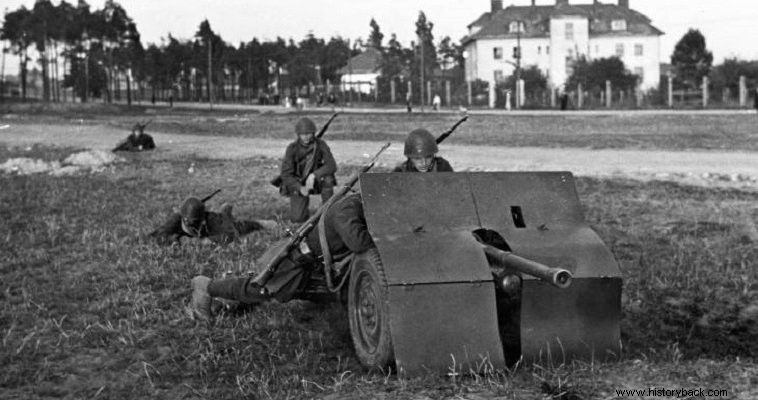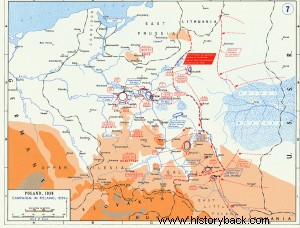
Lvov, today's Lviv in Ukraine, belonged to Poland in 1939. On September 1, Poland was attacked by Germany. The city was located close to the border with the then USSR and consequently had not been fortified by the Poles who did not foresee such a deep retreating maneuver.
However, developments were different. The Germans overthrew the Polish resistance in the west and Lviv became a key location for the establishment of the so-called "Romanian bridgehead" , of virtually the last site of Polish resistance to the invader, covered to the east by the USSR with its back to Romania.
On September 7, the Poles began to organize their defense in the area. The Polish forces, under General Władysław Lagner and Brigadier General Franciszek Sikorski. The Poles would defend on the line of the San River. However, for there to be defense there had to be forces.
The German attack
Lagner gathered all the men he found available, fugitives from disbanded units, auxiliaries, militiamen and formed a force out of them. On September 12, the 98th Mountain Hunter Regiment of the German 1st Mountain Infantry Division (IMF) under then-colonel Scherner arrived in the area. He ordered the immediate advance and the fastest possible capture of the city.
The Germans attacked but were repulsed by the Poles with existing casualties. At the same time, command of the Polish defense was assumed by Brigadier General Sikorski, who came from the Engineer's gun, under the supervision of Lagner.
The next day the Germans attacked again and succeeded in penetrating the center of the city but were again repulsed and retreated with losses. After that the Germans decided to surround the city and wait for reinforcements although they managed to capture the suburb of Zbojska.
The Poles meanwhile were reinforced by the remnants of the 10th Motorized Brigade. This force counterattacked and recaptured Zboika but failed to dislodge the Germans from the surrounding hills where they had lined up their artillery and pounded their opponents.
At the same time, the city began to be continuously bombarded from the air. The Germans furiously targeted the infrastructure of the city and the churches, but also the hospitals, not respecting any law of war.
Hitler's Red Allies
And while the Poles were holding out, they also received the attack of the 6th Soviet Army, which, based on the failed Ribbentrop-Molotov Pact, invaded dying Poland as a vulture to participate in the dogging of the corpse.
The Soviet invasion had as a first result the collapse of any dream of the Poles about a "Romanian bridgehead" and the preservation of a free part of Polish territory. Having no other choice, Sikorsky concentrated all his forces in a limited perimeter around the city.
On September 18, the Germans reinforced by the 2nd OMPA and elements of the 7th Infantry Division (MP) and the 5th Panzer Division (MPa) attacked again, but the indomitable Poles again repelled them. On the morning of September 19, the first Soviet tanks appeared east of the city. The first conflict took place in the suburb of Lysakov and was victorious for the Poles. However, by evening the Soviets had encircled the city from the east – as their German allies had left room for it.
Germans and Soviets blockaded the city from the west and east respectively. On the same day the Soviets sent an envoy to the city telling the Poles that the Red Army had come to help Poland and for that they had to surrender the city. But the Germans also sent a herald asking for the surrender of the city, warning that otherwise they would launch a general attack.
Capitulation
Faced with developments, the Poles could only choose which enemy they would surrender to. Sikorsky chose the Soviets. The Soviets accepted all of Lagner's terms but of course did not honor any.
Immediately after the Soviet troops entered the city, the Soviet SS, NKVD men followed and arrested all the Polish officers whom they later murdered. Among those murdered was Sikorsky. Lagner escaped and continued to fight but never saw his homeland free. He died in exile, "enemy of the people", in London.
The Polish defenders and their opponents
The Polish forces that fought for 10 days in the city had at their core the remnants of the 11th, 24th, 35th and 38th MP. The 10th Motorized Brigade had the remnants of the 10th Motorized Infantry Regiment and the 24th Ulan Regiment. Together with the volunteers the total strength of the Poles amounted to about 11 infantry battalions, a cavalry division, five artillery divisions and engineer elements.
The Germans began the battle with one regiment but gradually engaged two full mountain divisions and elements of an infantry division. As for the Soviets, their 6th Army had two cavalry divisions (each with 4 cavalry regiments and one tank regiment) and two armored brigades (each with four tank divisions).
German losses reached 2,000 men. Those of the Soviets were light. The losses of the Poles are not known, but they must have been significant.

